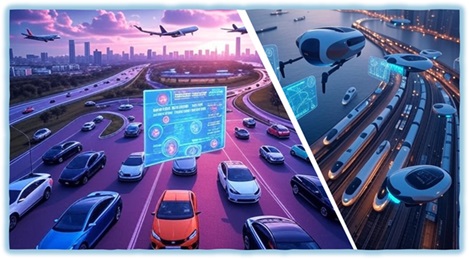
Moving America Forward: Steven Bradbury on DOT’s Vision for Safety, Infrastructure, and Innovation

Picture a weary traveler stuck in a packed terminal at Newark Liberty Airport, delayed by an air traffic control system running on floppy disks and copper wiring. Or a family grieving a loved one lost in one of the 40,000 highway crashes that claim American lives each year. These are the stakes faced by the U.S. Department of Transportation (DOT).
As the host of The Business of Government Hour, a weekly radio show and podcast dedicated to exploring leadership, technology, and innovation in government, I had the privilege of sitting down with Steven Bradbury, Deputy Secretary of the U.S. Department of Transportation(DOT). Our in-depth conversation explored the department’s key strategic priorities, its focus safety, its ambitious plans for infrastructure modernization, and its embrace of emerging technologies. Bradbury’s insights paint a vivid picture of a department at a transformative juncture.
This essay delves into the core themes and key takeaways from our discussion, offering a compelling perspective on how DOT is navigating its complex mission to enhance safety, rebuild critical infrastructure, and foster innovation for the benefit of all Americans.
DOT’s Organizational Framework: A Collaborative Ecosystem
From the planes soaring overhead to the roads we drive daily, the U.S. Department of Transportation (DOT) touches every facet of American life overseeing a vast and intricate network of approximately 55,000 employees across multiple operating administrations, each functioning as a distinct line of business under the leadership of the Office of the Secretary.
Bradbury likens DOT to a “big corporation” with the Secretary and Deputy Secretary at the helm, coordinating a diverse portfolio of agencies. These include the Federal Aviation Administration (FAA), National Highway Traffic Safety Administration (NHTSA), Federal Highway Administration (FHWA), Federal Motor Carrier Safety Administration (FMCSA), Federal Railroad Administration (FRA), Federal Transit Administration (FTA), Pipeline and Hazardous Materials Safety Administration (PHMSA), Maritime Administration (MARAD), and the Great Lakes and Saint Lawrence Seaway Development Corporation.
Each administration focuses on a specific transportation mode, from regulating aviation safety to funding highway projects and ensuring the safe transport of hazardous materials. Together, they form a collaborative ecosystem that balances regulatory oversight with infrastructure investment. DOT administers significant grant funding and loans, primarily to support state-led transportation projects, ensuring that federal resources align with local needs. This structure enables DOT to address the unique challenges of each transportation sector while advancing national priorities such as safety, economic development, and national security.
The department’s collaborative approach is evident in its partnerships with states, private industry, and international entities, such as the joint operation with Canada for the Saint Lawrence Seaway. Bradbury emphasized that this unified management, established when DOT was created in the 1960s, allows the department to tackle complex challenges with a cohesive strategy, ensuring that transportation systems operate safely and efficiently across modes.
Strategic Priorities: Safety, Infrastructure, and Innovation
Bradbury outlined three interconnected strategic priorities that define DOT’s agenda under Secretary Duffy: safety, infrastructure modernization, and innovation. These priorities align closely with national objectives, particularly in enhancing economic prosperity, national security, and public safety.
1. Safety: The Bedrock of DOT’s Mission
Safety is the cornerstone of DOT’s mission, and Bradbury emphasized the department’s commitment to reducing transportation-related fatalities and injuries.
He highlighted the sobering statistic that approximately 40,000 people are killed annually on U.S. highways, a persistent challenge that demands innovative and multifaceted solutions.
DOT is addressing this crisis through a combination of public education, regulatory reform, and targeted infrastructure investments:
- Public Education Campaigns: NHTSA is spearheading a high-profile campaign to promote safe driving behaviors, such as buckling up, avoiding distracted or impaired driving. Bradbury noted that nearly half of highway fatalities involve unbuckled occupants, emphasizing the life-saving potential of simple actions like wearing a seatbelt. He stressed the importance of both front and back seat passengers buckling up, as unbelted back seat passengers can become dangerous projectiles in a crash. The campaign also addresses issues like aggressive driving and driving under the influence of alcohol or drugs
- Regulatory Reform for Safety and Affordability: DOT is revising the Corporate Average Fuel Economy (CAFE) standards to eliminate regulations, such as the electric vehicle (EV) mandates, which Bradbury argued drove up vehicle costs. DOT aims to increase access to safer, modern vehicles equipped with advanced safety features, as newer models are significantly safer than older ones in crashes.
- Rail Grade Crossing Safety: DOT is addressing the longstanding issue of rail grade crossing accidents, which claim numerous lives annually. It is investing in grade crossing improvements to reduce accidents at rail-highway intersections. Grants are being allocated to fund modern gate systems and infrastructure separation projects, such as overpasses or underpasses, to enhance safety at these intersections. Bradbury noted that this issue has been a priority since DOT’s inception, reflecting the department’s long-term commitment to addressing persistent safety challenges.
- Performance-Based Standards: Rather than relying solely on prescriptive regulations, DOT is adopting performance-based standards to encourage innovation. This approach preserves private sector incentives to develop technologies like autonomous vehicles, which could reduce the 98% of highway crashes caused by human error. By fostering innovation, DOT aims to achieve significant safety improvements through market-driven solutions.
2. Infrastructure Modernization
DOT’s infrastructure ambitions are nothing short of monumental. The department is pursuing infrastructure projects to modernize the nation’s transportation systems, with two initiatives standing out as marquee efforts:
- Air Traffic Control Modernization: The FAA is spearheading a comprehensive rebuilding of the nation’s air traffic control (ATC) system, prompted by incidents like the mid-air collision at Reagan National Airport and persistent delays at Newark Liberty Airport. Bradbury painted a vivid picture of the current system’s outdated infrastructure—floppy disks, copper wiring, and leaking facilities—and stressed the need for a “soup-to-nuts” overhaul. This includes replacing copper wiring with fiber optics, upgrading radar systems, modernizing computer systems, consolidating Terminal Radar Approach Control (TRACON) facilities, and building new air traffic control towers. The $12.5 billion allocated through recent legislation is a critical first step, but Bradbury noted that additional funding will be needed to complete this multi-year project. The challenge lies in executing this overhaul without disrupting ongoing operations, requiring meticulous planning and phased transitions.
- Penn Station Redevelopment: Penn Station, a chaotic hub serving 600,000 daily passengers, is set for a world-class makeover. The current facility is outdated and inefficient. Under the leadership of Andy Byford, a public-private partnership will drive this long-term project to create a modern, world-class transportation hub. This initiative reflects DOT’s commitment to “building big, beautiful” infrastructure that enhances both functionality and national pride.
These projects exemplify DOT’s bold vision for infrastructure, aligning with the administration’s emphasis on transformative, high-impact investments.
3. Innovation: Embracing Emerging Technologies
From self-driving cars to drones delivering packages in 30 minutes, DOT is embracing emerging technologies that redefine transportation. NHTSA’s new autonomous vehicle framework will unlock commercial potential, while the FAA’s drone regulations will enable beyond-visual-line-of-sight operations, balancing innovation with security. Electric vertical takeoff and landing (eVTOL) aircraft and quieter supersonic jets promise faster, greener travel, while frequent space launches signal America’s leadership in the cosmos. AI is streamlining DOT’s operations, from hiring to rulemaking, ensuring a nimbler government.
Bradbury highlighted many of these key initiatives:
- Autonomous Vehicles: NHTSA is developing a new regulatory framework for autonomous vehicles, expanding waivers for testing vehicles without traditional controls (e.g., steering wheels and brake pedals) and creating tailored safety standards for autonomous systems. This framework aims to unlock the commercial potential of autonomous vehicles, which could revolutionize highway safety by eliminating human error, the cause of 98% of crashes. Bradbury emphasized the need for regulations that preserve private sector incentives to invest in this technology.
- Drones and Beyond Visual Line of Sight (BVLOS) Operations: The FAA is advancing regulations to enable routine BVLOS drone operations, critical for applications like package delivery, infrastructure inspections, and media coverage. Simultaneously, DOT is addressing security concerns by developing rules to prevent drones from entering restricted airspace, balancing innovation with national security. According to Bradbury, these regulations will unleash a “commercial bonanza” for the drone industry, enabling rapid delivery and other transformative applications.
- eVTOL and Supersonic Transport: The FAA is certifying eVTOL aircraft for urban air mobility, enabling efficient travel to airports and reducing ground congestion. Partnerships between airlines and eVTOL manufacturers are paving the way for new business models. Additionally, DOT is reforming regulations to support quieter supersonic aircraft, facilitating faster and more efficient air travel.
- Commercial Space Launches: The FAA’s role in licensing commercial space launches is expanding rapidly, with launches occurring every few days. Bradbury predicted a future where multiple launches occur daily, driven by streamlined regulations and technological advancements.
- Artificial Intelligence (AI): DOT’s AI governance board, part of its Non-Traditional and Emerging Transportation Technologies Council, is integrating AI to enhance efficiency in hiring, system operations, and public comment analysis for rulemakings. Bradbury emphasized the importance of responsible AI use to improve government responsiveness and effectiveness, ensuring that DOT serves the American public efficiently.
Streamlining Grant Management and Financial Accountability
A good portion of our discussion focused on DOT’s efforts to improve grant management and financial accountability, critical for ensuring cost-effective project delivery. Bradbury highlighted the department’s challenges in managing a diverse array of grant programs, which were previously tracked across multiple disparate systems.
Secretary Duffy has prioritized consolidating these systems into a unified, public-facing dashboard to enhance transparency and user-friendliness for grant applicants allowing applicants to their grants in real time.
Additionally, DOT inherited a backlog of over 3,200 announced but unobligated grants many tied to the Infrastructure Investment and Jobs Act (IIJA). Bradbury chairs a grant review task force that has processed nearly 2,000 of these grants, revising agreements to remove non-statutory requirements.
This “back-to-basics” approach he notes ensures that grants prioritize safety and efficiency, aligning with DOT’s core mission.
The department is also recovering unused grants, such as those from the Better Utilizing Investments to Leverage Development (BUILD) grant program, previously known as TIGER, and streamlining processes to deliver projects more efficiently. By eliminating extraneous policy priorities, DOT is enhancing financial accountability and expediting the allocation of resources to high-impact projects.
A Vision for the Future: Leaner, Smarter, and Bolder
Bradbury shares a vision of a much leaner, more efficient department that leverages technology, regulatory reform, and strategic investments to achieve transformative outcomes. The department is focused on delivering major infrastructure projects, such as the ATC modernization and Penn Station redevelopment, while advancing regulatory reforms like the CAFE standards and autonomous vehicle frameworks. By fostering innovation in emerging technologies, DOT aims to enhance safety, efficiency, and economic prosperity. Bradbury emphasized that the next three and a half years offer significant opportunities to achieve “bigger and greater things.” Bradbury’s insights underscored the department’s commitment to efficiency, accountability, and public service, positioning DOT to shape a safer, more connected, transportation systems.
He also shared heartfelt advice for those considering a career in public service, calling it a “higher calling” that offers unparalleled rewards. At DOT, the tangible impact of transportation on American lives—whether through safer roads, modernized airports, or innovative technologies—makes the work both fulfilling and essential.
He described the privilege of working on issues with “practical importance for everyday Americans,” emphasizing transportation’s role in supporting the economy, national security, and individual well-being.



